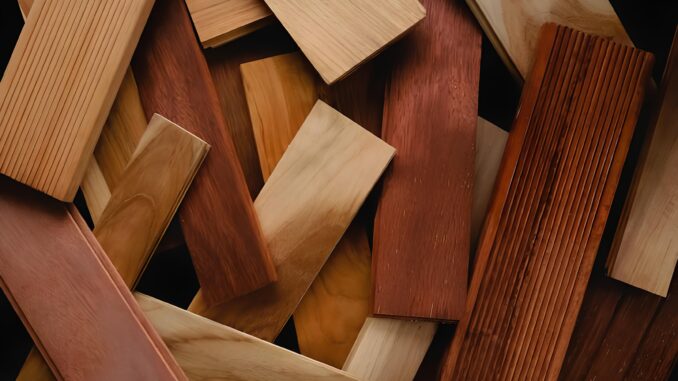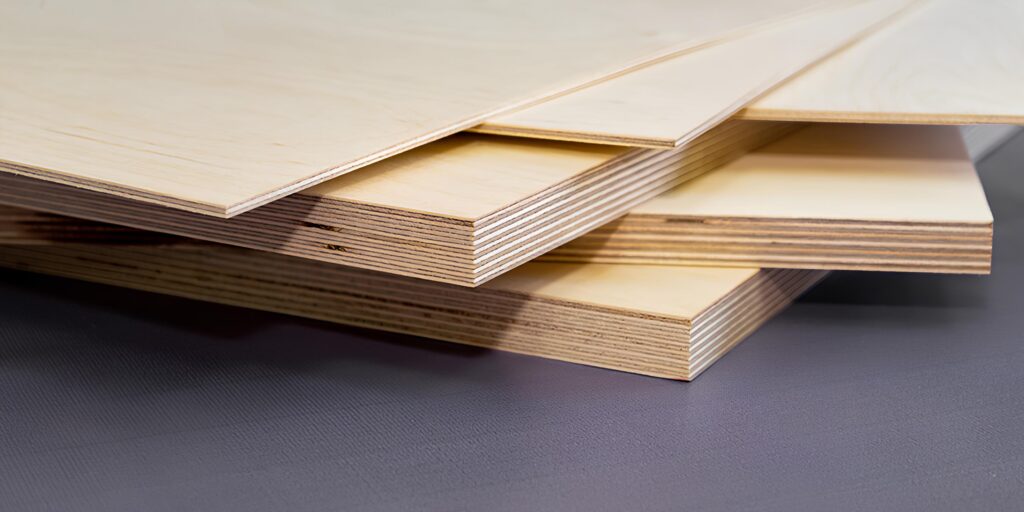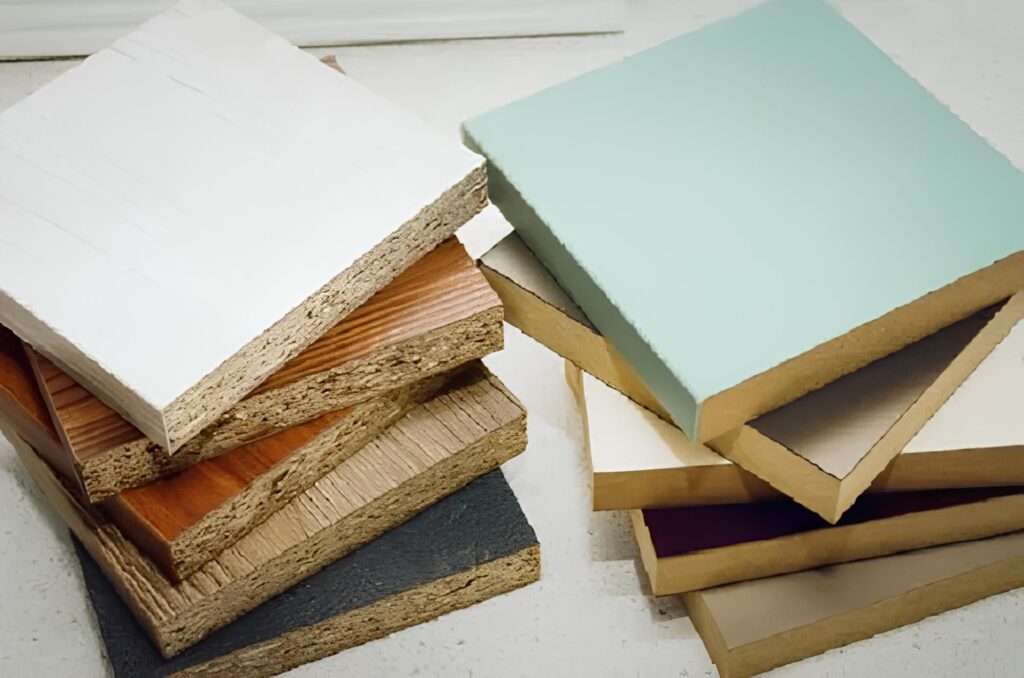
When planning any type of furniture construction, home improvement, or construction project, one of the key decisions that needs to be made is choosing between particle board vs plywood. These two materials are often seen as alternatives, but they differ greatly in many important aspects. Whether you’re constructing furniture, building a structure, or embarking on a DIY project, the decision between particle board vs plywood will impact the outcome in terms of durability, strength, cost, and environmental impact.
In this comprehensive guide, we’ll explore the differences between particle board vs plywood and help you decide which material is the best choice based on your specific needs. We’ll look at everything from composition to applications, as well as the pros and cons of each material to help you make a fully informed decision.
What is Particle Board?
Particle board is an engineered wood product created by bonding small wood particles like sawdust, wood chips, and other wood fibers together with synthetic resin or glue. These materials are subjected to heat and pressure to form flat sheets of board. Because particle board is composed of recycled wood products, it is typically less expensive than solid wood or plywood. It’s a versatile and budget-friendly option used in various applications, though its performance can be limited in some areas.
Composition
The main ingredients in particle board are small pieces of wood — whether it’s sawdust, wood chips, or even wood shavings — and adhesives. These components are mixed and pressed together into large sheets under intense heat and pressure. The adhesive used in particle board typically includes formaldehyde-based resins, which provide a strong bond but can emit volatile organic compounds (VOCs). The overall structure of particle board is quite uniform, meaning that the material is homogenous throughout, though it can lack the natural grain and aesthetic appeal of solid wood.
Common Uses
Particle board is frequently used in budget-friendly furniture, including flat-pack furniture, as well as in cabinetry, paneling, and flooring underlayment. It’s also a common material in low-cost construction projects or home renovations where the aesthetics or durability of the material may not be as critical. Since particle board can be easily shaped and manipulated, it’s often found in a variety of applications where strength is not the primary concern.

Advantages
- Affordability: One of the key benefits of particle board is its cost-effectiveness. As one of the most inexpensive wood-based products, particle board is ideal for those working with a tight budget or looking for affordable materials for larger projects.
- Versatility: Particle board can be used in a wide variety of applications, from creating affordable furniture to using it as an underlayment or backing material. It can be easily cut and shaped for different purposes, making it adaptable for a range of projects.
- Lightweight: Because it’s composed of small wood particles and fibers, particle board is relatively light in comparison to plywood. This makes it easier to handle during installation and transport, which can save time and effort on large projects.
Disadvantages
- Less Durability: Compared to plywood, particle board is more prone to damage under stress. It doesn’t have the same structural integrity and can be more vulnerable to breaking, cracking, or denting.
- Moisture Sensitivity: Particle board has a significant disadvantage when exposed to moisture. Without proper treatment or coatings, it can swell, warp, or degrade when in contact with water, which limits its use in areas where humidity or direct water exposure is a concern.
What is Plywood?
Plywood is another engineered wood product but differs from particle board in its manufacturing process. It is made by layering thin sheets of wood veneer, which are glued together with alternating grain directions to create a strong, flexible material. This layered structure provides superior strength and stability, especially in applications that require a load-bearing capacity.
Composition
Plywood is composed of layers of thin wood veneers, each glued together in a cross-grain pattern to ensure maximum strength. The number of layers, or «plies,» can vary depending on the intended use and the thickness of the plywood. The adhesive used to bond these layers is typically a strong resin that allows the plywood to retain its integrity and strength over time. Unlike particle board, the individual layers in plywood maintain the natural wood grain, which gives it a more aesthetic appeal.
Common Uses
The strength and versatility of plywood make it the go-to material for many structural and high-quality applications. It is commonly used in construction for flooring, subflooring, roofing, and wall panels. Plywood is also used in cabinetry, furniture construction, and even boat building, particularly marine-grade plywood. This material is favored in projects where durability and resistance to wear are paramount.

Advantages
- Durability and Strength: One of the standout features of plywood is its superior strength compared to particle board. It can withstand more stress and weight, which is why it is often used in structural applications. It’s also much less prone to bending, cracking, or warping than particle board.
- Moisture Resistance: Marine-grade plywood and treated plywood are highly resistant to moisture, making them ideal for outdoor or high-humidity environments. Unlike particle board, plywood doesn’t swell or degrade as easily when exposed to moisture.
- Longevity: Plywood is a long-lasting material that can endure years of use with minimal degradation. Its structural integrity remains intact over time, making it a durable investment for long-term projects.
Disadvantages
- Higher Cost: One of the major downsides to plywood is its cost. Due to the higher-quality materials and manufacturing processes involved, plywood can be significantly more expensive than particle board.
- Heavier Weight: While the strength of plywood is a definite advantage, it also comes with the drawback of weight. The multiple layers of wood veneer make plywood heavier than particle board, which can be difficult to handle during transportation or installation.
Key Differences Between Particle Board vs Plywood
Strength and Durability
When it comes to strength, plywood is far superior. The layered construction of plywood provides a great deal of resistance to bending, cracking, and warping. It can also withstand much more weight and pressure. Particle board, while versatile, is much weaker in comparison. It is prone to bending or cracking under stress, and its surface is more susceptible to damage.
Moisture Resistance
Plywood is known for its moisture-resistant properties, especially if you choose treated or marine-grade plywood. This makes it suitable for use in environments with high humidity or exposure to water. Particle board, in contrast, does not perform well under moist conditions. Without proper sealing, it will absorb moisture, causing it to swell, deform, and lose its structural integrity.
Weight
The weight of plywood is one of its defining characteristics. While it provides strength, its density can make it cumbersome to work with. In contrast, particle board is significantly lighter, making it easier to cut and handle, though this also means it lacks the strength of plywood.

Cost Comparison
The cost difference between particle board vs plywood is considerable. Particle board is a very affordable material, making it an excellent choice for budget-conscious projects or when materials need to be purchased in large quantities. On the other hand, plywood is more expensive due to the high-quality materials used in its production and its increased durability. If cost is a primary factor in your decision-making process, particle board might be the better option.
Aesthetic Appeal and Finishing
Plywood offers a more natural wood appearance, making it suitable for visible applications such as furniture, cabinetry, or decor. The layers of veneer add a distinctive wood grain, which can be highlighted with stains, varnishes, or other finishes. In contrast, particle board often has a less appealing surface, which is typically covered with a veneer or laminate to improve its look. The surface of particle board isn’t as refined, which limits its use for applications where aesthetics are crucial.
Environmental Impact
In terms of environmental sustainability, particle board has a slight edge because it is often made from recycled wood waste, helping reduce the amount of waste in landfills. However, the adhesives used in its production, particularly formaldehyde-based resins, can release harmful volatile organic compounds (VOCs) into the environment. Plywood is made from natural wood, and while it’s a renewable resource, the environmental impact largely depends on how sustainably the wood is harvested. Additionally, plywood manufacturing involves more intensive processes and energy use than particle board production.
Common Uses for Particle Board vs Plywood
| Application | Particle Board | Plywood |
| Furniture | Ideal for budget furniture, such as flat-pack items that don’t require high strength or durability. | Suitable for high-end furniture that requires both durability and aesthetic value. |
| Cabinets | Commonly used in kitchen and bathroom cabinetry where moisture isn’t a primary concern. | Used in high-quality cabinetry where both strength and appearance are important. |
| Flooring Underlayment | Provides a flat, smooth surface under carpets or other types of flooring. | Can be used as an underlayment, but more commonly used for structural flooring applications. |
| Wall Paneling | Used for internal partitions or decorative wall applications, especially in budget-conscious projects. | Suitable for more durable and aesthetic wall paneling, often used in commercial or high-end residential projects. |
| Structural Components | Not recommended due to its lack of strength for load-bearing applications. | Ideal for structural components like subflooring, roofing, and framing in construction. |
| Outdoor Applications | Not suitable for outdoor applications due to its susceptibility to moisture. | Suitable for outdoor use when treated for moisture resistance, such as in decks, fences, or garden structures. |
| Boat Building | Not recommended for boat building due to its poor moisture resistance. | Marine-grade plywood is specifically designed to withstand constant exposure to water in boat construction. |
Durability and Lifespan
Plywood is far more durable and long-lasting than particle board. The quality of plywood means that it can withstand years of use without compromising its structural integrity. In comparison, particle board has a much shorter lifespan, particularly when exposed to water or heavy traffic. Over time, particle board tends to degrade, and its surface can chip or break apart.

Ease of Use
Particle board is easier to work with because it is lighter and easier to cut and shape. However, it’s prone to surface damage, which can make cutting a bit tricky. Plywood is more difficult to work with due to its weight, but it holds up better under rough handling, cuts cleanly, and is less prone to damage.
Maintenance and Repairs
When it comes to repair and maintenance, plywood is easier to fix. Small scratches or dings can often be repaired without compromising its structural integrity. Particle board, on the other hand, can be difficult to repair if it’s damaged. Once the surface is compromised, it often requires a complete replacement.
Choosing the Right Material for Your Project
For Furniture
Plywood is the ideal choice for high-end furniture that needs to stand the test of time. For budget furniture or temporary solutions, particle board can offer an affordable alternative.
For Construction
Plywood is the material of choice for load-bearing applications and structural components. For non-structural uses like paneling or underlayment, particle board may be sufficient.
For Outdoor Use
Plywood is better suited for outdoor use, especially if treated or marine-grade. Particle board is generally not recommended for outdoor applications due to its sensitivity to moisture.
Conclusion
In the debate of particle board vs plywood, there is no clear-cut answer. Both materials serve different purposes depending on the scope and requirements of your project. If you need strength, durability, and resistance to moisture, plywood is the obvious choice. However, if you are working with a limited budget or need a material for non-structural purposes, particle board can be a highly effective solution. By understanding the specific advantages and drawbacks of each material, you can make a well-informed decision that suits your needs perfectly.